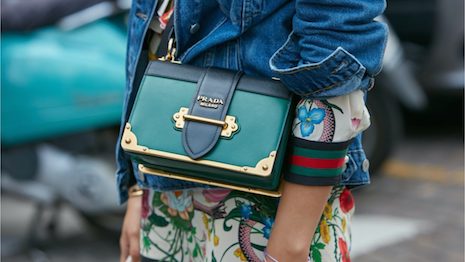By Wenzhuo Wu
Tofugear, a retail solutions provider with a focus on omnichannel commerce, recently released its Digital Consumer in Asia 2020 Report, which is based on a survey it conducted with 6,000 respondents across 12 markets in the region.
Among these targeted markets, China is often considered to be the most digital-savvy one, as nine out of 10 consumers prefer shopping via ecommerce to shopping offline.
To profile this sophisticated group, the report split its Chinese respondents evenly between Gen-Zers, millennials and Gen-Xers, while also splitting consumers evenly between upper-tier and lower-tier cities.
The overall differences between consumers living in the upper- and lower-tier cities turned out to be marginal, but lower-tier city consumers showed a slightly higher preference for online shopping than the other group.
Consumer behavior, motivations and sentiments between the two also varied in certain aspects.
For brands eyeing lower-tier markets, understanding these nuances is crucial for shaping their China strategies in a post-pandemic era.
Here, Jing Daily digs into three key takeaways from the report while sharing Tofugear’s exclusive insights on Chinese digital consumer trends as they relate to the luxury, fashion and beauty sectors.
Omnichannel strategies are the solution in China’s market in the long term
During the COVID-19 crisis, online channels became a lifeline for brands and retailers that wanted to stay connected to their consumers.
But as in-store traffic starts to recover in China, bricks-and-mortar stores will soon deserve more attention.
For Chinese shoppers, the top frustration when they shop in a physical store is that their desired product is out of stock.
Therefore, “offering immediate gratification” is essential for satisfying this important consumer demand, according to Philip Wiggenraad, Tofugear’s head of research.
For this, omnichannel strategies can deliver a better shopping experience to local shoppers.
“Retailers that have invested in omnichannel capabilities have real-time visibility of their stock and can direct customers to nearby stores or offer online fulfillment,” Mr. Wiggenraad said.
But cross-channel marketing and retail strategies can also develop valued customer relationships, considering that brand loyalty is now built through various touch points.
The report discloses how upper-tier city shoppers are noticeably more loyal to brands than lower-tier city consumers, with 38 percent showing a strong commitment to certain brands.
These attachments are cemented primarily through individualized services, such as personal shopping and consultations.
As this group has easier access to boutiques and offline stores, they often have chances to experience those services.
Consumers own various expectations about online shopping fulfillment
With its quickly developing technologies and communication networks, China’s consumers can access products through digital channels on the same level, whether they are in higher- or lower-tier cities.
However, the two segments show different expectations regarding online shopping fulfillment.
The report unveils how shoppers in upper-tier cities care more about fast delivery services, while their lower-tier city counterparts are less time-sensitive, and having access to certain products is more important for them.
Grasping this nuance is critical for brands that want to individualize their local strategies and reach targeted consumers more precisely and effectively.
However, digital consumers’ fulfillment preferences are becoming “more closely aligned” in lower- and upper-tier cities, based on Mr. Wiggenraad’s analysis.
That is because fulfillment services tend to be more unified as ecommerce giants such as Alibaba and JD.com elevate their logistics to support their luxury businesses.
Consumers in upper-tier cities hold a more positive economic outlook than those in lower-tier cities
At the time Tofugear conducted its survey, mainland China was facing significant economic disruption from the COVID-19 outbreak, which included city lockdowns, widespread travel restrictions and the adoption of strict home-quarantine measures.
Despite various indications that the economy has slowed down – from a massively struggling retail market to a jump in factory shutdowns – mainland China’s consumer confidence is among the highest in Asia, with 59 percent of consumers having a positive outlook about the economy over the next 12 months and 47 percent feeling secure about their personal finances.
In comparison, only 11 percent of Hong Kong consumers currently have a positive outlook on the economy.
The survey also indicates that, among these relatively optimistic Chinese respondents, consumers from upper-tier cities are slightly more positive than those from lower-tier cities in regards to the overall economic outlook and their financial situations.
This could be attributed to the way the country’s retail gradually resumed business after the pandemic was controlled, while the recovery of the rest of the world lags behind China.
Yet, many shoppers in lower-tier cities have grown used to purchasing luxury goods while traveling abroad.
“With overseas travel restrictions set to remain in place for some time, demand for luxury from within lower-tier cities could be quite firm once consumer confidence does return,” Mr. Wiggenraad said about lower-tier city markets in a post-pandemic China.
But, he adds, it will be critical for luxury players targeting these consumers to cater to their surging demand with heightened digital retail strategies.
Published with permission from Jing Daily. Adapted for clarity and style.
{"ct":"UOndaUol\/XbISpl8FR0sQFf5y5FDq4K1WcfUlvwroIaT3V9BncG6qlwKRG57JKfiHOBM3Y0B1GH4Lro9feaN6xPMJSN0ThRxxvbF2SR04aHv1b1L7zaaFQlUGK2551OmOntMIapSOL3BUclKzkX6CBl+tkxCl2T9DlhxUnw2U4QSu2yHdWqpk1sON6z6w\/uuIiQ4\/SRjjEuqwd2iw0FK0V+5I52fPuRA+CtXZE8mMek33ii1S+50pvehPxXtPuAMcQLlc1i7n\/xkJwkGFXIj4in2u6TOvWk9cnc8VqDnAKKMkC37NxAJ3Du2tiCE7\/WdfEtsfMVw2b0Xo95lzc6ZQgGcg1aSBq5H445lwXubRaxZ0IBfLL+h4J3M0APnwSs4OhlaMubvY8MQVt\/yEjKyIwcjiosxSRBS1YYpP8de8G8fhnnySGhBY6gu2Thaq08jp3nsUcIQhgi1mMlBWwJ+jZQ7CPxfWl9vZcaeJ+tEvKJKYpRLX8kOMlMViD3AgmUJBS8hYo3p3BOCV8WMYWinWhSqnOQ1uh6WTu9e34XPLLTZQ9n8\/6KtTCz9ihqS4iC5sGv0yDQyq85EK5bkgrJRgoiauuyYMio1AhR4tvlU+oxBQnejG\/UYh4HWoYzfwpm0dbpG4mGEXSc4R+akff3rCdMJ\/z+pkzMYWTU70X6s8vV3YVo3vAXgVMMaMJjZbiC26EX2J9FyV2E08\/9z0UgFepspAaK08\/P4x39liX10AE9Hg5RJt4NQi83ZpRxsyEMtdbLyCq8J6HGIr4zWy1N2eQ+SWLpRrLxhK0FI0J+2WjAATrIPX4MeNXsPrQRvwuMElbRvS1ZlcB6\/A7jP0Ov0MA9HLPoAZ+wC1m\/MIod4+WTwdOJE+U8lwqvB3U5DR10mkP7M2dCG0yf6I+zoAwr0e5SWXxapr5fy1WEjZJ9am7bb6msft4Dg1VOOZt7yZH+f75Slj0OCn4w6uuiBK\/bElCRpO7naTIqqKg778jdCBQs211xxmv9Av7wVJ3yXEcUPjDZimnrzqLquXF3PKybJ9BFKQm7awxLT5Gez3cLXZwtsGQgRNipDXZ\/njX4IXGRCQqsKcdtiCGZEjY8LrpLxbtvGwpydFQuIOUsHUmKbRKHsUu8rJoVrDZJ\/aoy3tmvgWFCKht\/crfP4Y5jQ98Tc+emdivzwHKUMyMkwyJqWZnzh3OmgxVmtduF2IQEwijFdIKIVJkLhIRkV6oAMbXgzuQ\/q\/62lNpTpikB\/tGjXXcfCqh40M0\/9ota9XVpiZRVUYfG56BkUIgajWm++2u\/6UNzTBDI9fW1kfpFG6Nhz+676pA8HWQgKQEs44IfAH5z05P2\/91FbpDq9VYUtSf1+soLI1X4fHIadzb\/n3m30vyNGOSI+swFlEfbE\/AYgSVIp54y41MR7EU6BBUmOVxzIy4Yjx6Trj76p2Mx+m9qmiPct7CwPN2tb4Bq0LI8PzCiXCv8wUjSFJoPlyFjdUzkH2pO+Kss6LVvGv9oH7+bejjfI2sfULyOWQ3mBCJ6ijmQ7fapKhdR6AULnEuQ5XsTxc3cgLiuo9YJRuSjo\/YtkqduwkzwbBeX6wGyG4HjZVeJxafWZTd\/RTKeuvx10U7vm28UZN4Niuw2zNA+BsCEcBGZ8ILMS1qJZHcUGBMIMISbW1LrS2WOcjSZjubgdfinyHJqygQih4y3RHTl1j8PLBNLeLmCqSZ7ZvNQPqvhqX6yzinLtzVEbZcs2ZKGd8Ddde8WwgFbrIMbo9y3n1cgVG3mZKTZjVc1JFC6mE+cib4x0gNNTtZdE2Ua2IZjzOY\/zE+zTCDPa9+Fdfwp4lyt\/n\/eWK00VnarNjK8Kr1+Oktl7v1Cm+CtK39FIeYpsafsv9iT6TqVq3Q+5RV9BNdDZesyi\/FKWsZTUohUQUXaiAMps0RpDC3YOaWVRrX+Xg0dckP84DZOY8BSovcz3TONbE5VdsupSnzn5gqkKR3K1x3\/EffAyTQyuGdKPgCgH2aYuM4\/wZ2Lf5vVeTd3jT6xVL2scdFQwn7U+0Dg+der+eeLzRN6x0MmGdR1YJ327MPIpNrMItx48+DozQqv0D\/sGluW31276man+pimX3EFgkCG9+KakoaTFQz+ppdKibegA6NAsCW8yPb4v8BoyRS77eCBPNqqCS3Jie1WHIKzVfGzZVbqxrvW5oCwN8OW\/LWDRDo41dvNVKexdA6lTYVenJX\/wkd4oU2xvTvOkl9LC5Oh7+dqMu1ymq7vY\/CRZDgBh8rkSc56Sazl4kkeBeNvXCub6RHUVtR+1RQCV+r4wwyP6AFQeugsZWDydJayTp4hJI11rrurKJEZdb58s1YMtbthnFZxnD0nz4huVLJstUOuQsn14YXZ+jTOliSFOLP+A3tzYBvoash7gwd4QSEd3A5OnsPV5ZlEjzEkF55BZ70l+1n9Iil9gmMvByLf9FVpT6CM74kUCwANAJYffYKunvC+\/dhO3g8afMXJOCEbWy7a70Dlj8iLKZnco4l7OzNsza+E3nFltPfdS1TpXuYpCBqd5f4fP9OPkVzeLtDfp9oUz5cU2WNQw3r6foKXpr0u3Owa1vQQU7HH2MhrdGFu3wJb56LD6Po5bEuWKFwf5VcLUa+\/1Vi2jxB0aqcJjz5Y\/rTEYYHsNwrxM8vSwcQ2KNcjKy+frfSp2uEocbe3FQGX0mOdxxFWFhOxIxDi6mpyTfGHWyBtbDmFj9m0pNutA8VZUiNWIz3xnOawBaGXxA\/JMYQ2HbPhnw52KkvLwRQ9s\/mrPFciQWataelttlbyXN7w2+ApFPqogopeSA1PRyKJLMc0zxr2uS+f3jw3I6dxkbtMjC153+afSXgWaaq0ONQA+tBnIeSIVgfpmZW3dH92oHDv66bjrJc68tzhWx8FIbppotDoWE3QvqRiwkSzxioFYfUFyGVlkBF2k7WgcyudK85BFSuzoaYLdRxAbJ6+YnQqZB9xwcYFqlf2mytYodTKJCQzAw16wKk4Z5hqXOkmmGHQlBGq93KI4GIg\/7C\/lRS1blRguZklUjC8DTRFIE2lwMyj90GHVsUF\/1DbrQTy4XCRuCQqw5OQutChoPXVZ5xiVkWAXc33TeHkSiy1uPQ95rAq1OeQn+Natgb0txuWM3M0KPh39DLnpg2dVKLh6zaDO9lhkmibxAkAarhdFOhXCPYt40BEJyqYRoaaej6ayNllutG75RMe5rRSRo8ro6TSD3M63T3B50vMOVdeuEGRfUXfaFAfnxE7CSYtgmNgCZocExLytEmioeruvAZSAF42RKprzwRDZ\/tUgrLd7+LHNwgd0tfIUqc4YPagsxpOc1nwxSWiHGNhe+J7XhKJ+mW\/yH5cLDXJABOC7svomojYVVAJC8S1GE5QwXswuUnqBErahoivKSDAqG5svun5uUV5w8VFUJKvc0b7pOd\/lYEHYkydWKc4dy9PebrB8wRGd2BA9gZHCGDWNkt84+syMCd56Z6NAuhb71b6q1Alwvsz3PhR9yTWr0Byg3jFlhH+6gvJyd\/esQ2TGDZHIU+lWzAH5lZYJBAoYC+ugDn7mGG57fVW40UV8hfZTpp7TDAnz8i+poZ0MtwuiW7jZmJkIfqBx0EJWHRmzBiJWx5Z8dHkWNEduLotlUS3bLJ6kfNJYTkkLupSvCsig8lgxZwXXqZQuHeOF6TNgjnktYqHvG4ak\/rH5R\/Q5\/4RlpsqVfdzKELapTbQB3ZWvQXnP8fgfQ7zK7J0UgyXTIrs0R8XhWsJtMoBBynmyDca\/9EZJX7IP\/3efVmNnzho0LdVuvmV1Ou4HSt7Zs9xbgISjBNl0h\/zboThq7HLKR9YXnN7QIW5P1E0vDtRqfhRZVmVLsE40jvg5TTFIwjOBv0Bi+UrSmU7ectemQYK5yRQhwufr78LbQH3CyJmwd4KzRwZSgozCv2IaWz3ZX7P62OZW2LyPnph0kaRTJAMhPAxRszcyueod3LCIsNmVsTTvv0dukvvYs1HNGGXgODiK54+HLfHg2z2MxKNzEWfKy3ku4wNgAYiCTsiSpsLLbT4d7yNvAZkHbQJ+l+xSGKPW4u0jGDIOFU04V0u9\/7yh6ckcAHoV3EGgcnuoGQrJAvHPL2cENTW\/PY7BGznH140gqyS6aoWhz9rCArG5QfLC3JncINMUB1Bza5Hw3gfzqy9t6bEuimtJHJUjLsUm+kRKyG\/RaSJE4BMnEOZYeXg\/SIgjWpxczhzrbbjvrt52OQQApAnkDbC8bNXR4LjXDmUHNkGk+Tzx\/apCzk+6KnblhcMeyeM6wxS3nvP9Ow+3EkIop5pZVA9Avm\/62uapt\/bJ+NAZh4eB0ufz+gFWPiEWpVGCGmmOxIBrPZwpQGAo3wSAu\/TT4PBj4VFtrBAkWf7whw6jIKARu1WRQqS+JWPV9K7+h5aDpqOjLxdrloo3SbZ9JzaWE3bl1qMRP8KSltN9hPaTUOkdK\/KGy3vzx8c\/yUPI6jfuNoff4siZ6zJOMe6qsaCt1r4eSzcfwk5ZVGbSw5g6yZ7mlffvBAZl7n5WMCO2H+6wmkGKNWHOM8aIF6XrzGXAaHjRJXJL+a\/hsuaPt8QgfDWASPnB2trpBKTFsut3m6CVcqe9Zo4oKe1cOyFWfikITPcnyjRuNWXRUJdMKZCK97V8jj\/0nOgiLDkvzFfuN4yOjPkt5WPeZk4p7sUznsrUrcE3OCNFaq\/YRzjedXxyCJGWuySxrW1FfjwyVPJJmngzs\/GKUUx6pHaAixmoyCm1FiKdZHGEhRzA6HuWCZ9jGyD4zQhoOMlHxeGlJYXngU45dRwXJH\/m4eQnhn8Ltvji+I81g3jRYuGMbbSpqH7UDcEKNGgUWcxm4jt\/ElzvXcreZvV1kty54DmZPb2bYT1H0wZ\/jLo0KPFUvP9BLnIwdzRtBfWcYGTNmZupk+9LaYa6lx2IgolHSmps+bCRWLqR2cxiuIWVh52+ADHgwx+ezdZDHs8gsFL4RYPgfAaaCY3x8Zo7z3w4af\/iMGDXU1pMkXm88N94+YyMhA0TyHxYsklq7tKGdk4gdFZcqzoShMMvgvH2eUJQTD7BYQvGu7kVwqWRuTlAjBkrUXdGSkgTbG0ryns5P\/lo57WV8H\/8j3seVVH9ps8\/2dFLUCx2goX6vplL16iLsIql+opIHUReDWbEKK9KaUreTlT3UIWQ0BVWWaEOPDq7qilK4nsIx6bqKmolAgSTo5gpmRau\/GTOVL7fld0VOI++QHtqHmtr\/nyBmes6z+L4NyrZA2SYhwh5j0PLa2cSG7igPDdr5GCCIx4HPQYyYnYncWjPZKzDxcj+s0H+SZlsDoF8tHP+6rc6IY3xTpEoXG3X\/Cv0wW7kzYkoLWRt\/K5Hq1yCG7kJw599oObnuuqmlpdEUv9o196ES1eJZQM2mXO7B9OArTRbIkjEG+aaiFi1+eiIyf6FndBPlKgVCiQ8Bd6Zpn3irw44FODM1Btf2IVS2B+ZAH48WKdVnh0yw66A5FrmQ95pHIk5BmYh4i9WJauGC6fhBuAwJFQ+C11+cw\/AbKqaW6j0GrZit\/Y7UYf2Sg5XlZs0v2TPaunVCNMqTrbLc1OyEhHaT2OFfswg4n\/rKzI\/X4LPh9uw8bEarLv4TROrJPkD\/tXMP40KXRMqhfKKi+sbu0r8GI72DNPvpbwwEe01enHmZkJB4LV2si\/XtXQZXJG2XGUuGNar4Lik2iCuehlKtt6J50H65b3hjFvQjGPYG\/duvt4RzPtcGLRt3amEf3v0NZxbXLge1bGbfIp\/Y+LCCWNzbYLlr5w\/NNbT1amgvvqRcz9Nu+hM9bufce6sviLYoDXLVqsCvVAhKHuZ9HN9nwQGPDP0yrhL6o3l8vqaTT0Y+Mrlesv0qrkJrYp42yQMzTCCdWNrJ5Cnvjv8pbId13uoRvau5gdQufKtYzeuDapEwbCqSPo7i1v1JV64EXlYtwI7WUaexE0GmCZA36xIiQkc8Ao4bOjICYjRed1p8H5jEIcYZBCz4xdD0HUOQthuEQBKbN++Zn2B4HlaHY7LXW1ZwF+UAbVKOjb\/IlD3djtB\/utFKv54DAPCAStjneE1P8kTJ9y8wAZb\/VZiAnvX+B9IAPRYkVtXHP7mCFf66RO\/ahjnsuqSUHlsI4DPAtsWdV\/ET6IzvQmc0Ydb4JJZDMm109TVgPFtnGk\/gHPVVnrMQo1rFx\/5VC9AY4NWRPUPLQlDEqTG2PpT7zYRgJ49ycStVa5zvCwsUtRcALUggaU\/h+fsuk\/b+SHbh7wyaZsL6Tj1yt6nRwy0TQIb9jHc8c4lXVAnYmMWDsrx6ApYWwg3218czGb0XPCYOWeY0MTYCab6uzsePNyomp9PltaXG1esSwUaiyGzMffqERppEdBR4JsGgxWUWvKaB+udcaAssLXTJlIxO2pKGihZ8Sow87Q0nF5yXRcHONuu1HX8ZzazreEwwD+Wjfb2IfNsHGLgqFylX7Qu+4jCgwpS8UFDS4IUuUwu\/OEIX8C1tZYE5eM6PO89DJXDOGErX6B3F7Pd0V0VXnahfOxEasUBPVn+SFO7mOozheQJdXlyLejOqi+UqTxP5ND2QzEkXDPXPA9RHwyNTdN91Pi0CVhEqIsPo8jnyZd2UYABSPkAv5iPCh8KuVqgaSW\/lz9XQwHvfstsrHClPlDGYUPaN1KVEXmL5htEkDbBfN76DhHOIbeq3p83KPSK2bH6lz2FbpiqP7cb6vEWRL1ekMmx\/T\/n1kqqPBlrB5+AQGfnzMjq7oNP7AkUlqMAYTqfkqVVzLbhKLDW23fclxfQ+4EXktePL290CfCiEWV6dt29pKjp0OzGAD9OuuJAYOuAVrmWdz93Yy0wGIdokhG8KRu1K052AocY1JDg2LzuvaL5k1RoCZiEIRiJ2HI6t\/Ue4JN4jrHzq+3ThGXYdortsoz0emRWpVBnuotv1CvBEJwGw+mL7D4ZOPQcB164J\/QJjgkuprKBUIP\/Tp1T\/\/FctliBfZ8cyOKzNNjvCh6U2K0JYVaGVMG7Ij6i75FDRaWlgXI9fvgYCc+V0sJG5kjRPV9iUtVi6T9iRhAzsbokljW7HIoS\/TaA1MNQwUPovQB4nNAxBgMa2mZmSrZ0aD4B+5MP\/eyG8OAldt+gSCYKlSkxBB00WC\/HxbcrRg7xjut7U+xHbtnqiHKlEfx3T4+f+WmqOgCdMgSYPfxmpDZUjyvabKS3jroUpinPz1SyAP0n6jvIHyQExczO\/pEJmHHbCuFAqYHH\/GE+2EZnTfptp33kGQHYufpNjq4dzBI9SSVFpHU2emL8J01v5seCn2gW5ThxYjhoeYcLCvj69lqAFbaThSqEcWr\/f059Mes2qnvHl0anmy87uT7iTS7QvdobsojqEtUNa4bJFZLIN\/hWTAImka3tP+AHq6WkILhV2T6PwMCw6u8Ps9XcLmqrdhESp20xhtWwZVAmIv61PnFBAFCS+W\/Bo1mwQa3Z4WtePB6OWvgQ\/mnDVCAKmRhsRzLkWE1Z4y2sw0LgiqV3ixx3qa1p3\/d0H8SJlzmBF\/0xlnGJU3pe3wY7lFnzjMaNc3IVq1TfRG5octCSeTZ8hpQ4Ox2TjDVMQLs+RplvvlEmAhLEwKVcV\/Yp6uN0uj7E4siGwnw2hFqdWQdaV0BBMIgmPcmMV45+rmLoEFgjH3iig3AUjts9Klfl9RzLnABJZi4vr4u1nbzB+231bppa9px9FOIL8XkHj+JH90lLGopidkhoIEwgQZLGOfv1WMbDQNPUzgNjYeZVbNhBaHyzURNbR+gWHobFtosg6lo1qGWKxnx60bX3J2XnBeKB1aENA\/SsuE0lyBsDzxkZDq26pkV6VZmIFyjr5ukrylICCFOtryXAGZTJm0xbEf2AoBhCV2UtGImAUOCB2SGyu8hFE8bwJdLckExNeeIN9fUhifPlUy7SyeaJ0tKL5bqbYO99FTa3CWu8beZ7HNtExwrKzM8cLrRfrOlbYd\/yru1BcJe7\/fDOulJC04WemmIo3uWgTVDRYsw2B2BCYlEErticyYfY8\/HNMAZpyZXYsb5fsMb02GcLAbiWemaxMD6qIdSjDhAVx7h3n6PSQGowVPiTBy+kjN3jC6ShCiN8Sev\/93y9Dk4QAH4\/tNqhB4eQmlD9lDc6NLoC7k7lncug7vibffSGgJwanSwvfui3pmR4V+LPPE5Du3AHkaGBECtruV7O+798fqPBEZgyaP26ta24vx3PCxve\/ucOzfoOHx2euteFM+QA4dj3Mwsx0gTbs1hm7+mZJUFef1V3G1KPXR7CdTFXQWixmCHZT7jvne5FqMaAKaORwWeWnRSHxWv61jlOjSedmEqoAOReIQcvfoJ3kfBVu9naYAP6LCOc1UOJAUsYFKTF8fHyo+ykHCslDEdM5vYdxjH\/k78KN1XlZjw9uUe9p36CxZ9tVys8qT7ZjsVYVvfG\/HRuRKDuECwDuxr3weMj9N94WRfACEkv99n\/\/BpTC3iVCfQArO\/QQVOXhpeM1bNSi9nEfgg8AKB1NkHsEJe4SO4BPbK\/fP92ZgKf3Zkom4R0ptNqbLQktjykyEDQ5\/fVriJ5QxIXsPP4CllwhrdPC0C\/HNsK\/YF+jRpMUAH4O7VZ0DjGZYI4Ufmn5beV9oS1FNfxUDyamXOiLmbvjrheAtcufLF\/xCQyeJmMVx1RYiNdYlDN4m4sa43Azmc2iStc8yt4Sj7JXcJ2SbBa21TFEzI9hvUpXTdi5Lh3Ovk6ir4r7jR1WD\/NGArdGBLuNvpvTyxqyDE5WxBS8719zRftpcVfUil93CieKoDBOPHPLWEEMuj1HcqIJeADa8yEx1kKPT2S6vdImunSIZKeOldDumAI3qcUjJpyENKygWrZzjc6ckmEVSfirpL45aTL1YskocRzhi1SzZBXExtGCWbL\/uFUFuEgJ1Oaaa3DaUFhg6pAihanF9Dtx1NJSElD9lBkuupb78IBjjdsDW2H46\/h2lXZAXDiaAKh90LLhasxi3xWB2O4JDysgKeAiIV0wOYfeixGqopJO8cPE7\/SFrudoM6IXociTaGZWMUBfvgXi18I+pR3wM8VKGzOX7OlTf7Vp+3HzoqbOERxGLcvp+qUkxHnu1vlEvgd8W8JaDMwjQDPOhX6b\/wu2y96f1UvpZTMTyGFU2oQq8nCnSE6MsedOv\/nuppE7c1F+9wdbw9AMS2t9Etke8DloueWVvLeY5+NdKDC6ObXL\/An2g4FMeaBHEi9tl0bsQtH2grw\/l9N\/VVCIM8RIf2kU6j6fq2YDpiWxzmy2fCdxOmYzjyAJgKCyZA6jlZggW6CUW\/3xVG9fkKqNb0U6zi7XeaJHU\/8Z7gtPSu7pCwxP7JXnLr\/axHrF6a6LTQCDtXFbCA9\/ErF0FCB8eojZ1WNNOfvW2a4WWsav8mHXK+uNysYBxb9qgu1NveAfrm6zpMhxmJsGv39NC5lHEZLQNQKNdBwXEo7a3OoBlbR5D0kb75QUPW\/ZyJskdZFMQJlyJ7xggYyx85JR0qA7pup9G4kDkhLGYkyn+csugNQboflFb8EXWh\/Ha3c2eQtDmnS3081JG1+LlNjak\/a2IsEBFI7KBmEssz80egERCVMHelDBxsaM4f\/AMoFJBNCB6Npma8lGM3gBdPF2QEgQleRyNQy+vTzurmnLtNS4WZuT3evdtSbgtcYNC3nMown5cXhrraR66CWhWSIaXfKLL9Qhs7FWS\/88mj53J5\/vR1ucqxcwUP8QwBTHM45wsdTnHUdGXnfBYqtszeq4wa01Bb\/qBYR6Bwzde6amUN+eB5kVHw5656P8eEEAA2vkVahe0YYZq7SuKbNhE\/8esOnlSNLRPVmEMwOzzWy+is=","iv":"f012f1f5b72eed46b489be6620b2dfd8","s":"d793853e093abd3e"}

 Tofugear’s new Digital Consumer in Asia 2020 Report profiles Chinese shoppers and how these consumer groups vary in their post-COVID-19 shopping habits. Image credit: Shutterstock
Tofugear’s new Digital Consumer in Asia 2020 Report profiles Chinese shoppers and how these consumer groups vary in their post-COVID-19 shopping habits. Image credit: Shutterstock